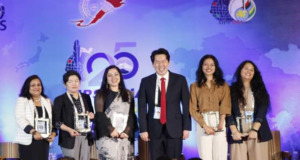 by Nava Thakuria
by Nava Thakuria
Guwahati: A dire need of increasing female representation in sports journalism emerged as the talk of AIPS Asia Women’s Forum, which was organised alongside the 25th AIPS Asia Congress in Kathmandu of Nepal recently. Through a panel discussion on the issue, the forum raised a pertinent question whether more women sports journalists should be welcomed in the traditionally male-dominated industry.
Mentionable is that sports journalists representing 22 Asian countries assembled in the meet, hosted by Nepal Sports Journalist Forum on 12 September for the Asian division of International Sports Press Association (AIPS) to discuss the future of Asian sports and the way sports journalism can march forward, reported the global organisation representing sports journalists (https://www.aipsmedia.com/aips/pages/articles/2024/35853.html).
The panel discussion, moderated by Indian multimedia sports journalist Prarthana Hazarika, brought together a diverse panel of accomplished women, including journalists and athletes, to reflect on the obstacles women continue to face in the sports media landscape. The forum was a powerful reminder of how much work still needs to be done to ensure that women’s voices are equally heard in sports media.
While sports journalism is evolving, the forum highlighted how many women still struggle to break through, facing institutional bias, a lack of mentorship, and limited opportunities. The industry is often dominated by men, particularly in decision-making positions, which stifles the diversity of perspectives that women can offer. Many female journalists find themselves assigned to ‘soft or lifestyle’ roles rather than being given the opportunity to cover major sporting events.
Shivanee Thapa Basnyat, senior presenter at Nepal TV, shared her personal journey, reflecting on the discouragement she faced when she first entered the industry. “When I started my career, there was little to no encouragement for women to pursue sports journalism. It was a field dominated by men, and many women didn’t even consider it as a viable career path,” she explained. However, Shivanee was optimistic, pointing out that the situation is improving, with new doors opening for women. “Now, we see more opportunities, but that’s why it’s even more important to bring more women into the fold—to further enrich the sports landscape with our perspectives.”
As the discussion evolved, the forum also touched on how female athletes often find it easier to relate to female journalists. Janni Jensen, former athlete and representative of the Esports Federation shared that women athletes are more likely to open up to female reporters, creating a deeper connection that allows for more authentic storytelling. “It’s about trust and understanding,” she said, adding, “Female athletes feel understood by female journalists because there’s a shared experience, a shared understanding of gender-related challenges. This connection often leads to richer, more genuine narratives being told.”

This perspective is particularly relevant as women’s sports receive more media coverage. However, male journalists still dominate the field, and that imbalance can result in women’s sports stories being under-reported or misrepresented. Jensen emphasized that without more female journalists, we risk missing out on the nuanced and compelling stories of female athletes that male counterparts may not capture as effectively.
Offering an international perspective, Jing Xu, vice president of the Chinese Sports Press Association shed light on China’s commitment to empowering women in sports journalism. She noted that the number of female journalists covering the Paris Olympics was significantly higher than in previous years, thanks to targeted initiatives aimed at promoting gender equality within the industry. Jing explained how China’s media sector is making strides in elevating women’s roles, but also emphasized that progress is still ongoing. “We’ve seen great advancements, but there’s still a long way to go. The presence of female journalists in major sporting events is crucial to telling more inclusive stories,” she added.
Palesha Gaverdhan, a para-athlete and bronze medalist from Nepal, highlighted how women’s underrepresentation in sports journalism affects para-athletes like herself. “Our stories are often left untold,” she asserted, underscoring how many para-athletes struggle to get the attention and recognition they deserve in mainstream sports media. She called for more female journalists to take on the responsibility of bringing these stories to light. “We need women in sports journalism to champion the stories of para-athletes like me. These stories are important, but they often remain in the shadows,” she stated.
Throughout the session, there was unanimous agreement among the panellists that there is an urgent need for more female representation in sports journalism. It was clear that women’s voices are vital to improving the coverage and understanding of not only women’s sports but the entire sports ecosystem. The speakers highlighted that the presence of women in the industry isn’t just about equality—it’s about creating richer, more nuanced stories that resonate with wider audiences.
“Women journalists bring a unique perspective, one that is necessary for the industry to evolve and better reflect the diversity of the sports world,” said Prarthana Hazarika from the chair of moderator. She also thanked AIPS Asia president Hee Don Jung and general secretary Amjad Aziz Malik for their support and expressed hope that more women will soon be visible in sports journalism. “We have made strides, but we still have a long way to go. With support from organizations like AIPS Asia, I am hopeful we’ll see more women breaking into this industry soon,” she concluded.


